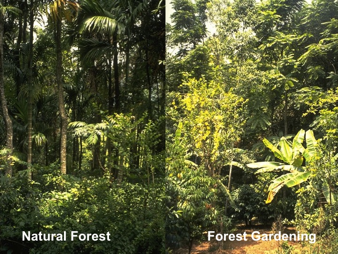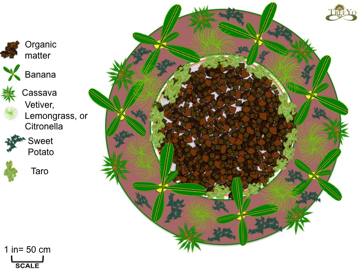Permaculture is a holistic progressive green design movement that focuses on working with the laws of nature to fulfill human needs to create a sustainable human society. It touches upon most aspects of our lives including food production, construction, energy, the arts, politics, economics, and much much more. In short, Permaculture is the synergy of Agriculture (the resource element), Ecology (the sustainable element), & Landscape Architecture (the design element) to create low input (work), high yielding (resource) systems to fulfill all of our needs to live on this planet; while at the same time working to create a more diverse, harmonized, & sustainable ecosystem for the planet. Just imagine going from endless miles of mono-crop agriculture that requires endless amounts of fertilizers, pesticides, herbicides, & now genetically modified plants to maintain its yield to a Permaculture based agriculture, a way that fulfills all of its needs with minimal human input and produces abundant amounts of resources to fulfill our needs as well as natures! Just picture the Garden of Eden! Permaculture works with nature rather than resisting nature. It is a method that is so natural, harmonized, empowering that suddenly problems like Global warming, ecological destruction, & economic melt down are put in perspective and we realize that we can help the world overcome them!
 |
| A Charming Depiction of Permaculture on the Farm Scale |
A Quick Definition
Permaculture is the harmonious integration of all life kingdoms into agriculturally productive ecosystems and socially just environments producing sound economic consequences. It’s a regenerative design science reflecting patterns in Nature that seeks to build interconnections allowing for energy efficiency and abundance of yield.
Why Use Permaculture?
With the use of this revolutionary design science our society has the capacity to redesign its future through building resilient communities and efficient economies of scale.
- Reversal of desertification
- More biologically active soils and efficient nutrient cycling through reception of water
- More productive rangeland or cropland
- Removal of existing Carbon Dioxide from the atmosphere
- Enhanced profits & livelihoods partly through reducing costs
- Improved wildlife habitat
This movement encompasses the relationship we as humans have in stewarding this planet and brining abundance back to fruition.
THE DESIGN PRINCIPLES
A Food Forest
Creating a food system that is based on perennial species, those that come back year after year, is one of the underpinning values of Permaculture. A key component in doing this is what we call a food forest or garden forest. When designing these food forest systems, we strive to mimic the stacking potential that natural forests display. This is especially true when working within tropical climates. Alternatively when we use techniques that are indigenous to the northern climates of Europe in dry climates or the tropics, we have disastrous affects, which can be seen in the southwest of the USA and across Australia and Africa.
The image below illustrates how a dry tropical area with a prolonged dry season would look.
As you can see the forest is extremely diverse which is one of the key principles of Permaculture. For the sake of avoiding redundancy, each principle from this point on will be bolded instead of being directly referenced. Diversity can be seen here through varying plant heights and the fact that even some produce yields underground. Also the plants will produce at different times and a continued source of food and cover for the soil is provided. These ideas are summed up as plant stacking and time stacking, where we use the solar dollar to its maximum. Biological resources are being used here as the legumes fix nitrogen as explained above. This eliminates the need for expensive and destructive chemical fertilizers while also providing the shade below for the crops that thrive in tropical partial shade. I could go on and on with all eleven principles but for the sake of space and time I will show one more example that is a staple of permaculture in the tropics. But first, look at the photo below. The forest on the left is natural while the one on the right is totally filled with medicinal, edible, or fuel-wood plants. These images demonstrate the powerful biomimicry of Permaculture Design.
At present, many farmers are already being encouraged to diversify their crops because monoculture requires pesticides and fertilizers. These chemicals are destructive to ecosystems as we all know but they are equally devastating to farmers’ profit potential. By having multiple elements that support one function (food production), crops can thrive in symbiosis.
The Banana Circle
This design feature in particular, illustrates clearly all of the 11 permaculture design principles. It really offers the opportunity to get people to change their paradigm around numerous environmentally detrimental misconceptions. The banana circle is a diverse planting that encapsulates the principle of small-scale intensive. Rather than spreading bananas out over a broad distance and then having to use a lot of chemicals and manpowered energy to maintain the monoculture and waste of space, the banana circle can pack in lots of food production in a small area.
The design is multifunctional as it is a place to grow banana and other food crops, a place to put detritus from the yard or household like fruit peels, and even a place where the kitchen sink water can be diverted for cleansing and plant reuse. The depression in the middle is a place for organic matter to be piled and water to collect. Bananas are heavy feeders on both water and nutrients so this “mulch basin” is essential. The water and organic matter which turns into humus is thus in relative location to the bananas. By placing elements next to each other they can create functional interrelationships just as forests do with ecological food webs. The lemongrass is in relative location to the bananas as well, since they can be continually cut for mulch on the mound while also being a strong scent to deter pests.
A common practice in tropical areas is to burn organic matter. Instead of burning, which destroys soil health, this organic matter can be used as food for the soil and thus play an integral part in the process of ecosystem restoration. Once a vibrant and diverse ecosystem is established, it will provide food in abundance for humans and animals alike. Again we are always aiming for closed loops in design, as the waste of one thing is always the need of another thing in Nature.
In conclusion, we offer this final take on “what is Permaculture” by founder Bill Mollison. It emphasizes the unique opportunity that we all have to redefine how humans inhabit this planet. Permaculture Design and Holistic Management offer powerful models for how to proceed.






